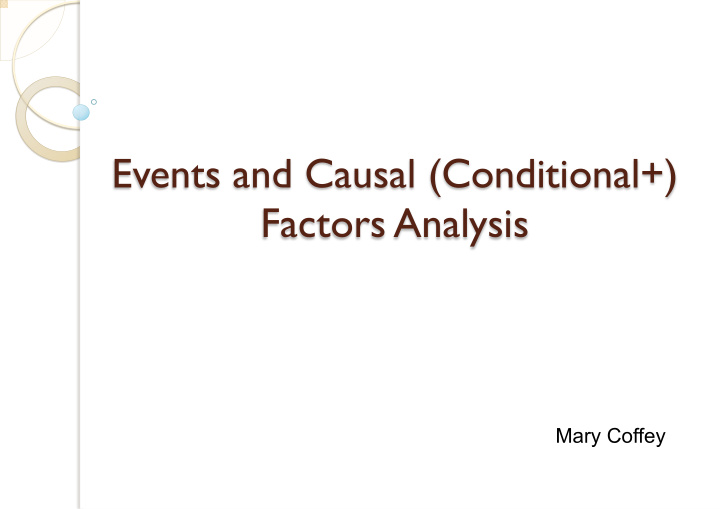



Events and Causal (Conditional+) Factors Analysis Mary Coffey
ECFA and ECFA+ ECFA – Buys and Clark 1995 ◦ Assists in verifying the sequence of events leading to the incident and the possible causal factors for each event ◦ Provides a structure for integrating investigation findings ◦ Assists communication during the procedure as it must be a team approach ◦ Assists communication in reporting back the findings ◦ Buys and Clark 1995
ECFA and ECFA+ ECFA+ - The Noordwijk Risk Initiative Foundation ◦ Further refinement of the ECFA through experiences gained over a decade ◦ The Noordwijk Risk Initiative Foundation
ECFA (Buys and Clark) Incidents rarely simple and almost never result from a single cause ◦ Multifactoral Human factors Environmental conditions Omissions Oversights Performance related ◦ Different conditions may affect different elements of the incident
ECFA (Buys and Clark) The incident and its component elements The conditions that created incident situations The managerial control systems that let them develop ◦ To identify the root causes by understanding the interaction of events and causal factors through a chronological chain of activity starting with an initiation event through to the final event of the incident
ECFA (Buys and Clark) Will help to ◦ Organise the data on the incident ◦ Guide the investigation ◦ Validate and confirm the true incident sequence ◦ Identify and validate factual findings, probable causes and contributing factors ◦ Simplify organisation of the investigation report Not used in isolation ◦ Most effective when used in conjunction with other tools
ECFA (Buys and Clark) Will help to clarify responsibilities and reduce incidents by ◦ Providing a cause-oriented explanation ◦ Providing a basis for change ◦ Helping to delineate areas of responsibility ◦ Acting as an operational training tool ◦ Providing an effective aid to future systems design
ECFA (Buys and Clark) Aids in developing evidence by ◦ Detecting all causal factors ◦ Illustrating multiple causes ◦ Providing a visual representation of interactions and relationships ◦ Illustrating the chronology of events ◦ Providing a flexible interpretation ◦ Linking specific factors to organisation and management control factors
Retrospective: Events and Causal Factors Analysis Representatives of all professionals involved Presented with an incident ◦ Analysis in terms of Clearly identifying and mapping the primary event Considering possible contributory factors Systemic conditions Systemic factors
ECFA - Events and Causal Factors Analysis Typical ECFA work team using PostIt and a White board http://nri.eu.com/NRI4.pdf
ECFA - Events Events What, When, Who 1. Define what you consider to be the primary incident – what actually happened- and enter the individual events in sequence in the central row 2. Track in logical progression from beginning to end (try to define the logical sequence)
ECFA - Events Events What, When, Who 1. Important that you describe an actual occurrence and not a condition 2. Events are active so use a verb for each event and be precise 3. Describe each event separately
ECFA - Events Events What, When, Who 1. If appropriate define what you consider to be secondary events and place these in the rows above or below the primary event
Primary and Secondary events MLC Incomplete points Appears saving of moved to Error Final plan ‘frozen’ plan holding message calculated area displayed Secondary events Planner Plan modification Old New responds Second Appears Plan save fluences fluences save yes to requested by ‘frozen’ attempted deleted created error attempted clinician message Primary Events
ECFA - Contributory factors Contributory Influences Factors 1. Describe states or circumstances 2. Passive and not active 3. Conditions that could have influenced the event or if they had been different might have resulted in a different outcome
Plan assessment Complex data Complex error before fraction Contributing storage message one inadequate Factors MLC Incomplete points Appears saving of moved to Error Final plan ‘frozen’ plan holding message calculated area displayed Secondary events Planner Plan modification Old New responds Second Appears Plan save fluences fluences save yes to requested by ‘frozen’ attempted deleted created error attempted clinician message Primary Events Request for change during treatment Contributing Factors
The exercise - Events 1. Read the incident carefully 2. Transcribe all the actions onto individual post-it notes 3. Place on the chart in what you consider the sequence to be 4. Review
The exercise – Conditions/ Contributory factors 1. Consider the conditions that existed when the incident occurred 2. Write all the conditions on post-it notes 3. Match conditions with the different elements of the incident 4. Add conditions to the chart 5. review
The exercise – Conditions/ Contributory factors 1. Identify what you consider to be systemic conditions or systemic factors 2. Review and agree on your final configuration
Retrospective: Events and Causal Factors Analysis Management or supervisor Systemic factors failure Too many Systemic condtions Heavy workload staff Unclear Staff not Senile Lack of Lack of Observation Contributing factors setup familiar w Patient communication equipment failure instructions patient Patient Patient Beam Beam Treatment Unit Treated wrong Primary events changed positioned on Beam selected positioned positioned Service target/isocenter treatment unit couch incorrectly incorrectly Field/target Field names Contributing factors connection confusing missing R/V design Systemic condtions flaw
Recommend
More recommend